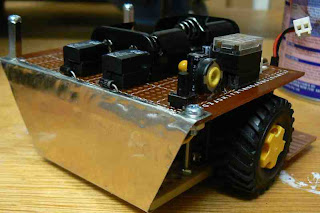
Nudgebot rear shield ready for abuse
Although sumobots aren't battlebots there is still going to be some wear and tear from bumps, falling off tables, etc. Looking at the rear section I thought there was a good chance that during bouts the motors cables might be damaged. So I decided to add a rear shield made out of light sheet metal to protect them.
The metal I used was from a Sun unipack disk enclosure. It originally was the shielding on the top of the disk enclosure. It is quite light but in the small size I was using and having it secured at four points it should be solid enough. I used some tin snips to cut out a rectangle of metal and then marked out the size of the bottom plate and cut at an angle to the top of the sheet. This was me trying to be fancy. I used a vice and small engineers hammer to work the metal into shape. Then I marked out and drilled the four attachment points (two top, two bottom). I had to be very careful with the drilling as even the 3mm drill would twist the sheet metal out of shape. Also on the top lip I had to cut out a recess around the components which I used tin snips to cut out. That was a bit rough so I should have used the cutting disk on my Dremel instead. A lesson learnt for when I get to making the front scoop and shield for the line sensors later on (and another reason I did the rear shield first - to work out all the things I shouldn't do).
Finally I will need to paint the rear shield (most likely black). Highly reflective sheet metal is light a flash light in the dark to infra-red detectors. Don't want nudgebot making things too easy for better sighted opponents.


